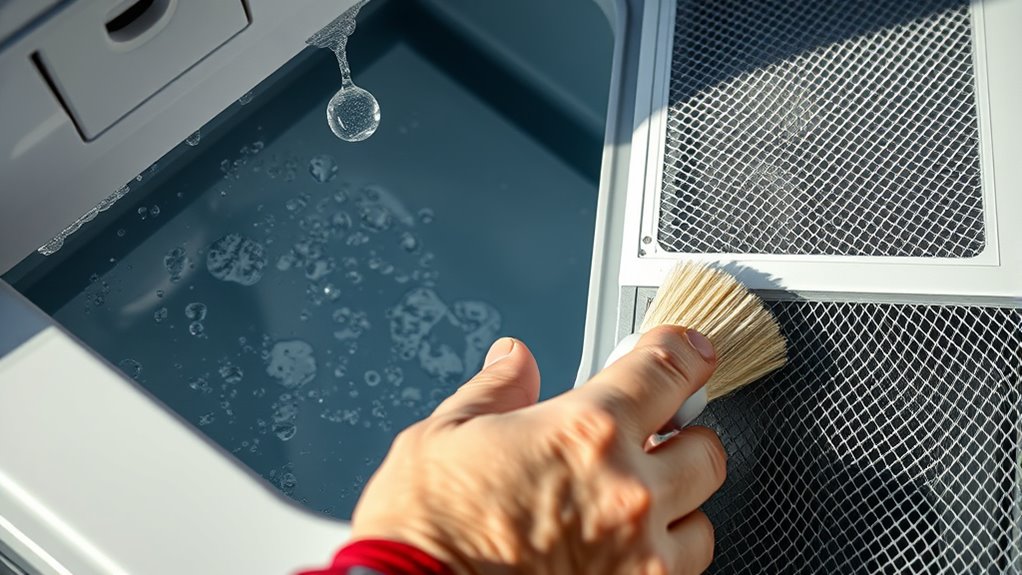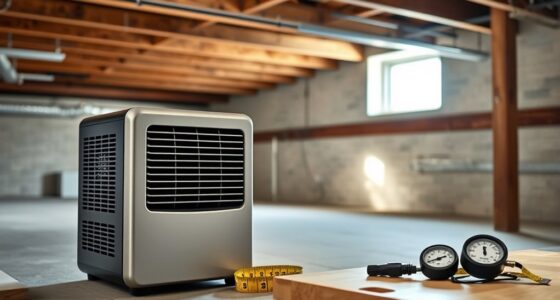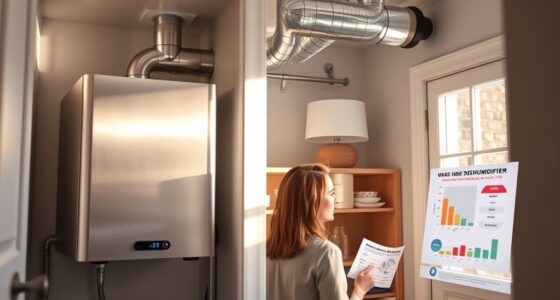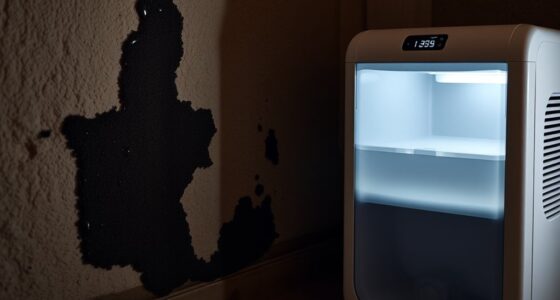To keep your dehumidifier running smoothly, regularly clean the water tank by unplugging the unit, emptying, and scrubbing with soapy water, then disinfecting with vinegar. Wash or replace the air filters monthly, making sure they dry completely before reinstalling. Clean the coils with a soft brush or coil cleaner to prevent mold and maintain efficiency. Checking internal parts and scheduling professional maintenance ensures peak performance—continue with these tips to keep your dehumidifier in top shape.
Key Takeaways
- Regularly unplug the unit, remove the water tank, and clean it with warm, soapy water, then disinfect with vinegar or mild disinfectant.
- Wash or replace air filters monthly, ensuring they are dry before reinserting to maintain airflow and prevent clogging.
- Use a soft brush or vacuum to remove surface dirt from coils, then clean with coil cleaner or mild detergent, rinsing thoroughly.
- Check vents, filters, and fan blades for dust and debris, and verify humidity calibration with a hygrometer for accurate operation.
- Schedule professional maintenance annually to inspect coils, filters, and internal parts, especially in high-humidity environments.
How to Properly Clean the Dehumidifier Water Tank

Cleaning the dehumidifier water tank regularly is essential to keep your unit running efficiently and prevent mold growth. To do water tank cleaning effectively, start by unplugging your dehumidifier and removing the water tank. Empty any remaining water and wash the tank with warm, soapy water. Use a soft brush or cloth to scrub away any dirt or residue. For tank disinfection, mix a solution of water and white vinegar or a mild disinfectant, then let it sit in the tank for about 15 minutes. Rinse thoroughly to remove any traces of cleaning agents. Dry the tank completely before reinserting it into the unit. Regular water tank cleaning and disinfection help maintain ideal performance and prevent unpleasant odors or mold buildup. Additionally, monitoring for vulnerabilities in your appliance’s software can help prevent security issues related to smart features.
Replacing and Washing the Air Filters for Optimal Performance
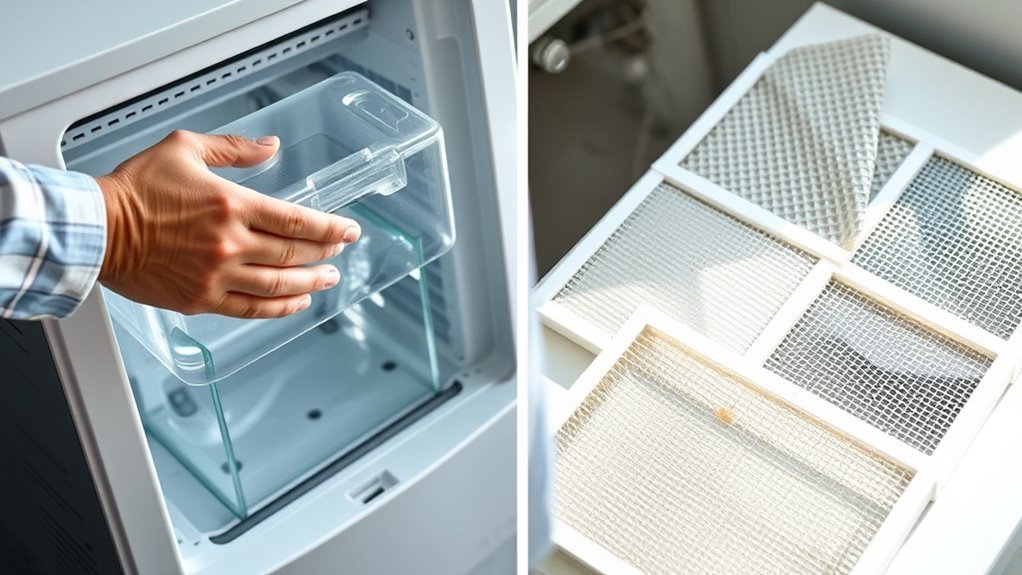
To guarantee your dehumidifier operates efficiently, it’s important to regularly replace or wash the air filters. Air filter replacement ensures dust, dirt, and allergens don’t clog your unit, maintaining peak airflow. If filters look dirty or clogged, it’s time for a filter washing—remove the filter and clean it with mild soap and water. Make sure it’s completely dry before reinserting it. Washing filters is a quick, cost-effective way to extend their lifespan and keep your dehumidifier running smoothly. Regular maintenance routines help prevent strain on the system, improve air quality, and ensure your dehumidifier operates at maximum efficiency. Check your manufacturer’s instructions for recommended cleaning frequency, typically once a month.
Cleaning the Coils to Maintain Efficiency and Prevent Mold

Since dirt and moisture can accumulate on the coils over time, it’s essential to clean them regularly to keep your dehumidifier running efficiently. Coil cleaning removes dust, debris, and mold spores that can hinder heat exchange and reduce performance. Use a soft brush or a vacuum with a brush attachment to gently remove surface dirt. For deeper cleaning, turn off and unplug the unit, then use a coil cleaner or a mixture of mild detergent and water to spray the coils. Let it sit for a few minutes, then rinse with water and dry thoroughly. Regular coil cleaning not only maintains peak efficiency but also helps prevent mold growth, which can cause musty odors and compromise indoor air quality. Incorporating data-driven strategies can further optimize your maintenance routine for sustained dehumidifier performance.
Tips for Inspecting and Maintaining Dehumidifier Components
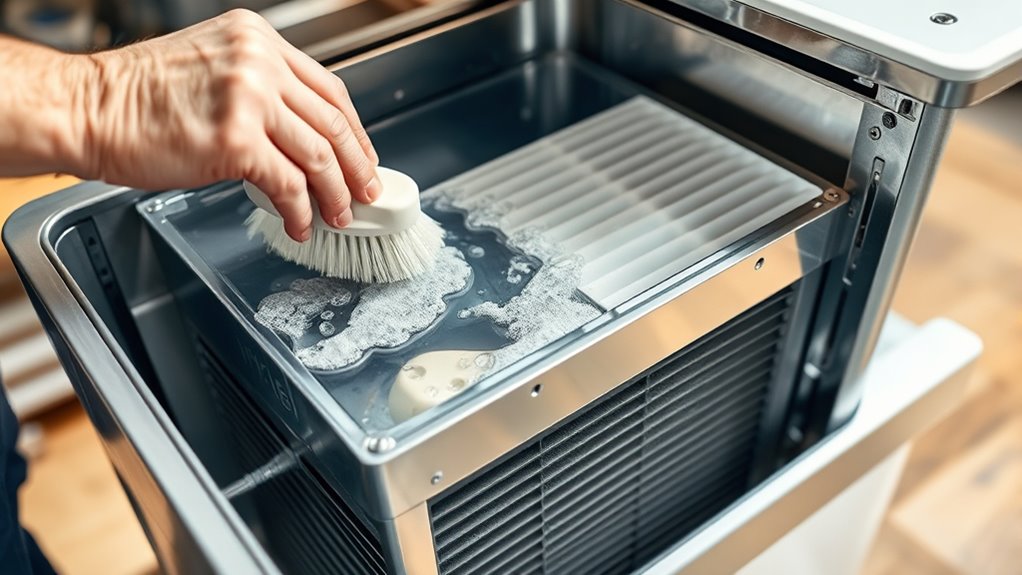
Regularly inspecting your dehumidifier’s components guarantees it operates efficiently and prevents potential issues. Check airflow pathways to ensure nothing blocks vents or filters, which can hinder airflow enhancement. Clear any debris or dust from vents, fan blades, and filters to maintain proper air circulation. Also, verify humidity calibration by using a hygrometer to compare your dehumidifier’s reading; adjust settings if it’s off. Inspect coils for dirt buildup or corrosion, cleaning them if necessary to improve heat exchange. Examine electrical connections for signs of wear or damage. Maintaining these components helps your dehumidifier run smoothly, conserve energy, and maintain consistent humidity levels. Regular inspections empower you to catch problems early, extending your unit’s lifespan and ensuring peak performance. Additionally, understanding contrast ratio can help you choose models that provide clearer visuals if you’re also interested in home cinema setup.
When and How to Schedule Professional Maintenance

Scheduling professional maintenance for your dehumidifier guarantees it continues to operate efficiently and prevents unexpected breakdowns. You should plan for a professional inspection at least once a year, especially if you notice reduced performance or unusual noises. Maintenance scheduling becomes easier when you follow your unit’s manufacturer recommendations, which often suggest annual check-ups. A qualified technician can assess components like coils, filters, and other internal parts, ensuring everything functions properly. If your dehumidifier operates in a high-humidity environment or sees heavy use, consider more frequent professional maintenance. Timely scheduling helps catch issues early, extends the lifespan of your device, and maintains ideal humidity levels in your space. Don’t wait for a failure—regular professional inspections keep your dehumidifier running smoothly.
Frequently Asked Questions
How Often Should I Replace My Dehumidifier’S Air Filters?
You should replace your dehumidifier’s air filters every 1 to 3 months to guarantee optimal filter replacement and maintain good air quality. Regularly changing filters prevents dust, mold, and allergens from circulating, which can affect your health. If you notice reduced airflow or increased dust around your unit, consider replacing the filters sooner. Proper filter replacement keeps your dehumidifier running efficiently and helps improve overall air quality in your space.
Can I Clean the Coils With Household Cleaning Products?
Imagine your dehumidifier’s coils as tiny, delicate forests needing gentle care. You can’t use household cleaning products on coil maintenance; they might damage the delicate fins and reduce efficiency. Instead, opt for a soft brush or a coil cleaning solution designed for appliances. This keeps your coils clean and functioning smoothly, much like tending to a garden, ensuring your dehumidifier breathes easy and works efficiently day after day.
What Are Signs My Dehumidifier Needs Professional Servicing?
If your dehumidifier makes unusual noise or you notice electrical issues like sparks or frequent trips, it’s time for professional servicing. These signs suggest internal problems or electrical faults that could worsen without expert attention. Don’t ignore persistent noise or malfunctions; they could indicate a need for repairs. Regular professional checkups guarantee your dehumidifier runs efficiently and safely, preventing costly damage or breakdowns later on.
Is It Necessary to Empty the Water Tank Daily?
Oh, the thrilling task of water tank maintenance—because who wouldn’t want to daily empty a container of what should be a dry, dust-free haven? You don’t need to do it daily unless your dehumidifier runs constantly in a damp basement. Typically, regular dehumidifier scheduling involves checking the tank every few days; if it’s full, empty it. This keeps your device running efficiently and prevents overflow disasters.
How Do I Prevent Mold Buildup Inside the Dehumidifier?
To prevent mold buildup inside your dehumidifier, you need to prioritize mold prevention through proper dehumidifier hygiene. Regularly empty and clean the water tank, and wipe down the interior surfaces to remove excess moisture. Keep filters clean and replace them as needed, and ensure coils are free of dust and debris. Good airflow and maintaining a low humidity level also help inhibit mold growth, keeping your appliance safe and efficient.
Conclusion
Regular dehumidifier maintenance is like giving your appliance a fresh breath of life. By cleaning the tank, filters, and coils, you keep it running smoothly—like a well-oiled machine. Don’t forget to inspect parts regularly and schedule professional check-ups when needed. With a little effort, your dehumidifier will continue to be your trusty guardian, keeping your home dry and comfortable like a gentle breeze on a warm day.
